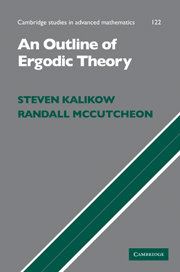1 - Measure-theoretic preliminaries
Published online by Cambridge University Press: 05 June 2012
Summary
1. Discussion. In this opening chapter, we offer a review of the basic facts we need from measure theory for the rest of the book (it doubles as an introduction to our pedagogic method). For readers seeking a true introduction to the subject, we recommend first perusing, e.g. Folland (1984); experts meanwhile may safely jump to Chapter 2.
2. Comment. When an exercise is given in the middle of a proof, the end of the exercise will be signaled by a dot:
The conclusion of a proof is signaled by the box sign at the right margin, thus:
Basic definitions
In this subchapter, we discuss algebras, σ-algebras, generation of a σ-algebra by a family of subsets, completion with respect to a measure and relevant definitions.
3. Definition. Let Ω be a set. An algebra of subsets of Ω is a non-empty collection A of subsets of Ω that is closed under finite unions and complementation. A σ-algebra is a collection A of subsets of Ω that is closed under countable unions and complementation.
4. Comment. Every algebra of subsets of Ω contains the trivial algebra {∅, Ω}.
5. Exercise. Let Ω be a set and let C be a family of subsets of Ω. Show that the intersection of all σ-algebras of subsets of Ω containing C is itself a σ-algebra.
- Type
- Chapter
- Information
- An Outline of Ergodic Theory , pp. 5 - 25Publisher: Cambridge University PressPrint publication year: 2010

